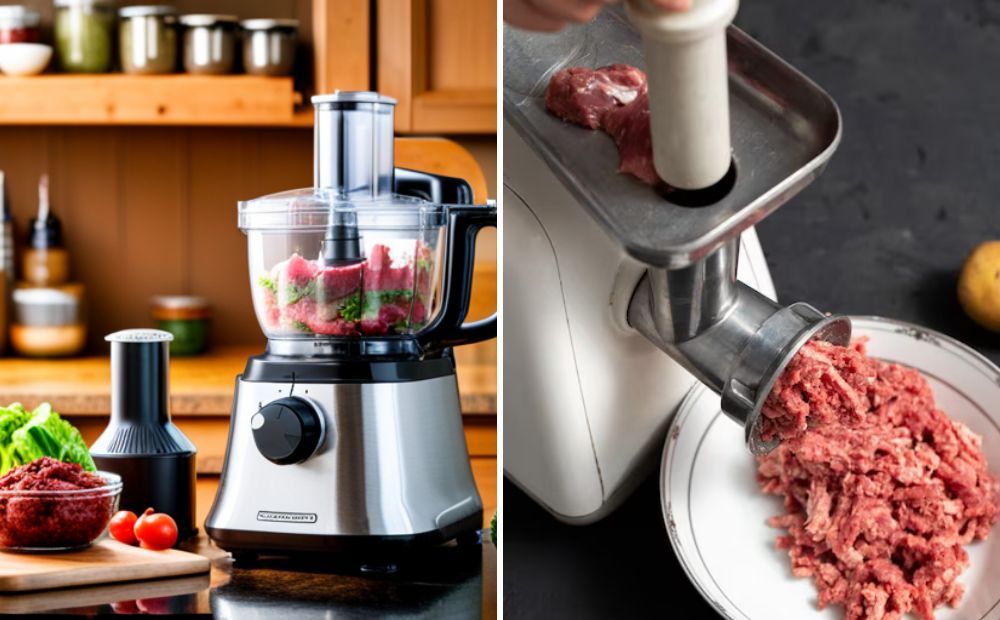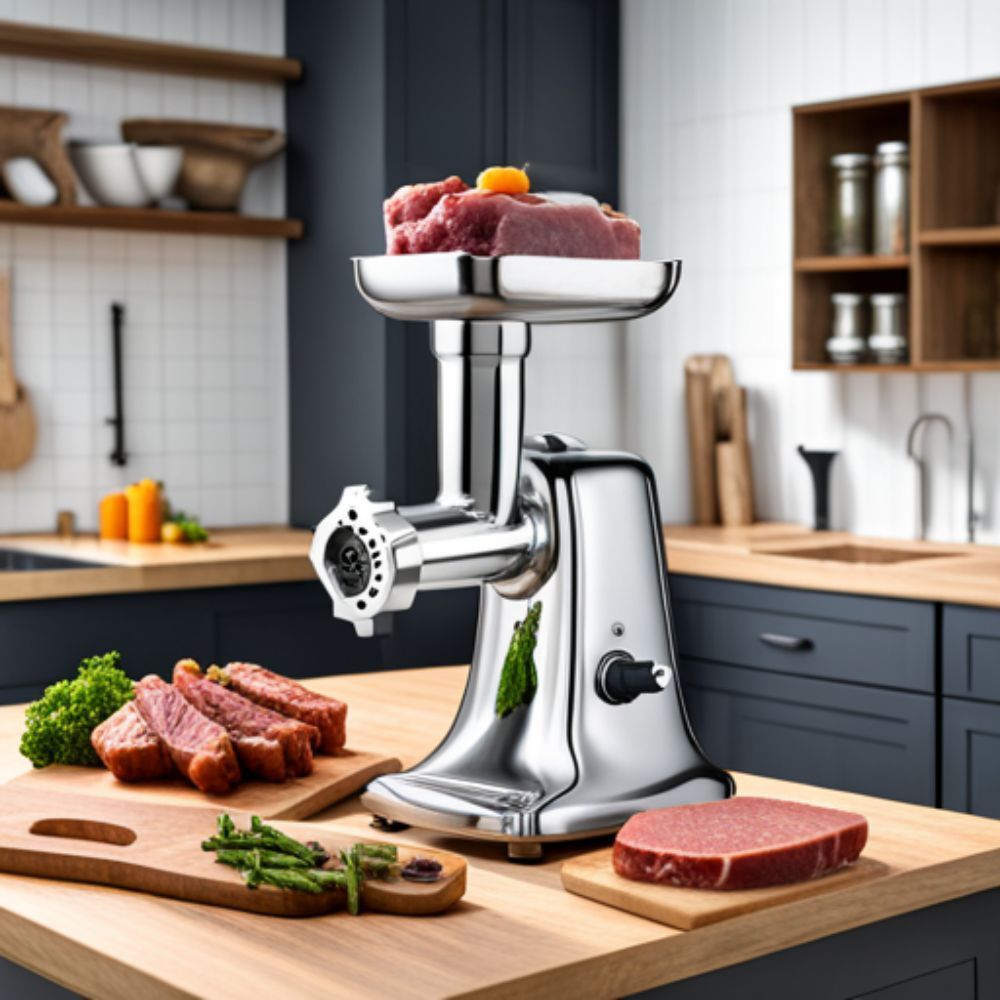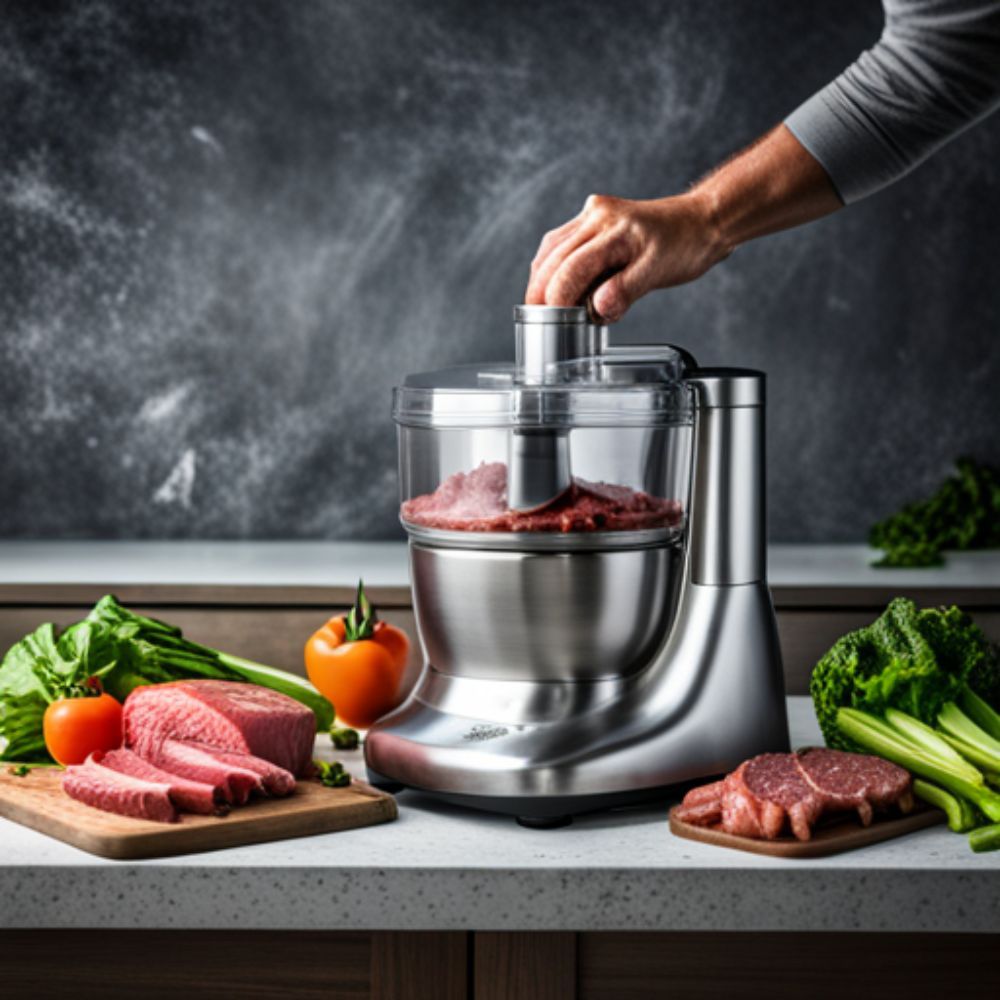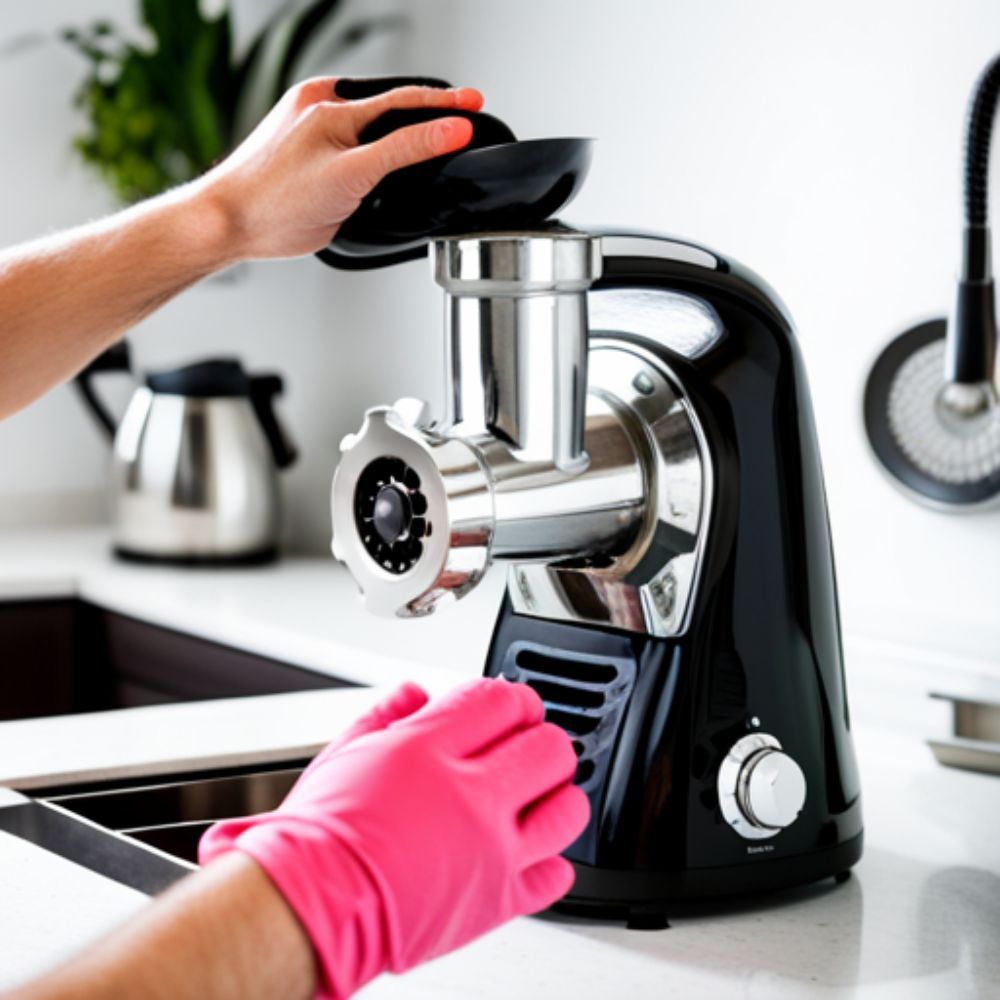The endless battle of choosing between a food processor vs meat grinder for your kitchen can be daunting.
Both appliances come with their own set of advantages, and deciding which one is the right fit for your culinary needs can be a challenge.
Fear not, we’re here to help you understand the differences, functions, and versatility of food processors and meat grinders, so you can make an informed decision.
In this blog post, we’ll explore the capabilities and limitations of both appliances, compare their cost, cleaning and maintenance requirements, and discuss additional uses for each.
We’ll guide you through the process of selecting the appropriate appliance for your kitchen based on your specific needs, usage frequency, budget, and desired tasks.
Ready to dive in? Let’s get started with the food processor vs meat grinder comparison!
Key Takeaways
- Food processors and meat grinders offer different functions for food preparation.
- Meat grinders provide more control over the grinding process, while food processors are easier to clean and maintain.
- Consider functionality, capacity, power, attachments & accessories before making a choice that fits your kitchen needs & budget.
Understanding Food Processors

A food processor and a meat grinder
A food processor is an electronic kitchen tool equipped with multiple functions, such as:
- Chopping
- Slicing
- Shredding
- Pureeing
- Kneading dough
This versatile appliance is not limited to just grinding meat, it can also be used for making finely ground meat and finely chopped meat.
Imagine the convenience of having one kitchen appliance that can handle your food preparation needs, from chopping vegetables to producing minced meat.
The main attraction of food processors is their ability to perform various tasks in the kitchen, which makes them an alternative to electric meat grinders for some tasks.
These appliances come with different settings to suit your needs; low speed for mixing and chopping, and high speed for pureeing soups, smoothies, and juice.
With a food processor, you can have more control over the quality and texture of your ground meat, as opposed to store-bought ground meat.
Types of Food Processors
In the comparison of grinder vs food processor, bear in mind that:
- Food processors are designed for a wide variety of food preparation
- Meat grinders are specifically for grinding meat
- Food processors come in different sizes to cater to various needs, such as full-sized, compact, and mini versions.
Your specific needs and the tasks you aim to accomplish will determine the size and type of food processor you select.
Compact food processors are suitable for smaller kitchens with limited counter space, while full-sized versions are ideal for those who require more power and capacity for their food preparation tasks.
Food Processor Attachments and Blades
Food processors come with various blade attachments to help you achieve different results in your food preparation.
The blades and disks are capable of making pasta dough, slicing and chopping vegetables, and pureeing soups.
A food processor is more versatile than a meat grinder, as it can perform tasks that are typically performed by both meat grinders and other kitchen appliances.
Equipped with the right attachments, your food processor becomes a multitasking powerhouse, adept at fulfilling a variety of kitchen needs like chopping vegetables, mincing meat, and kneading dough.
Understanding Meat Grinders

Meat grinder
While food processors are known for their versatility, meat grinders are specifically designed for grinding meat, allowing for superior control over the end product in terms of texture and consistency.
This results in quality ground meat that can elevate your dishes to new culinary heights.
Meat grinders are not limited to grinding meat alone. They can also be used for grinding fish and vegetables, making them a versatile addition to your kitchen equipment.
However, these appliances are more specialized, and their primary function remains grinding meat.
This specialization offers advantages such as decreased preparation time, superior control over the end product, and the ability to handle large quantities of meat.
Types of Meat Grinders
Electric and manual grinders are the two primary types of meat grinders available in the market.
Electric grinders are more accurate and powerful, making them suitable for grinding large quantities of meat, while manual grinders are more appropriate for smaller quantities and for those who prefer a hands-on approach.
Your specific needs, the frequency of use, and the tasks you seek to achieve with it will dictate the type of meat grinder you choose.
Electric grinders tend to have a higher price tag, but are generally more efficient and powerful, while manual ones are more affordable and offer simple controls for grinding meat.
Meat Grinder Attachments and Plates
Meat grinders come with different attachments and plates to regulate the size of the grind and ensure uniformity of the meat.
These attachments include cutting blades, sausage stuffing tubes, and various sizes of grinding plates, such as fine, medium, and coarse.
The blade or auger in a meat grinder is used to push the meat through the plate. This ensures an even texture of the ground meat.
This even texture is one of the primary advantages of using a meat grinder over a food processor when it comes to grinding meat, as food processors often produce unevenly minced meat.
Grinding Meat: Food Processor vs Meat Grinder

Food processor grinding meat
Grinding meat using a food processor and a meat grinder can yield different results in terms of texture, consistency, and ease of use.
While a food processor can be used to grind meat, it may not provide the same level of control and consistency as a dedicated meat grinder.
The grinding process in a food processor involves:
- Placing the desired cut of meat into the container
- Pulsing on low for approximately 15 seconds
- Increasing the speed to medium and pulsing for an additional 30-45 seconds.
On the other hand, a meat grinder works in a different way. It pushes meat through the holes in the grinding plates and then spins blades which cut the meat into small pieces of desired size.
This process yields a smooth and even texture, unlike the uneven texture produced by a food processor.
Ultimately, the choice between a meat grinder and a food processor will depend on your specific needs and preferences when it comes to grinding meat, and understanding the differences in a “meat grinder vs food” processor comparison can help you make the right decision.
Preparing Meat for Grinding
Proper meat preparation is vital before grinding in either a food processor or a meat grinder. Freezing lean meat and cutting it into smaller chunks is recommended.
This helps to ensure that both appliances can easily process the meat and produce a consistent grind.
It’s also necessary to keep the meat cold during grinding to preserve the texture and quality of the ground meat, including ground beef. By following these simple preparation steps, you can ensure that your ground meat is of the highest quality, regardless of the appliance you choose to use.
Grinding Process and Results
As discussed earlier, the grinding process and outcomes can differ between food processors and meat grinders.
Food processors tend to produce a finer texture, but may not provide the same level of control over the final product as a dedicated meat grinder. Additionally, using a food processor for grinding meat can result in over-processing, causing the meat to become pasty.
In contrast, meat grinders offer more control over the output, as they provide different plates such as fine, coarse, and medium, allowing you to achieve your preferred texture.
This type of control is not available with a food processor, making meat grinders the preferred choice for those seeking a consistent and even grind for their meat.
Cleaning and Maintenance

Cleaning a meat grinder
When deciding between a food processor and a meat grinder, cleaning and maintenance are crucial aspects to consider.
Food processors are generally more straightforward to clean, with dishwasher-safe components such as the bowl, blade, and cover. Cleaning a food processor usually involves:
- Removing all blades and attachments
- Filling the appliance with hot water and dish soap
- Shaking it for 30 seconds
- Dumping out the water
On the other hand, cleaning a meat grinder can be more labor-intensive and time-consuming.
Meat grinders require disassembly and thorough cleaning of all components, making them less convenient than food processors when it comes to cleaning and maintenance.
However, if you’re willing to invest the extra time and effort, a meat grinder can provide you with superior control and consistency when grinding meat.
Cost Comparison
In comparing the costs of food processors and meat grinders, it’s important to consider aspects like appliance type, size, and additional attachments.
Food processors typically range in price from approximately $20 to more than $200, depending on size and brand. In general, food processors tend to be more cost-effective than meat grinders.
Meat grinders, on the other hand, range in price from $40 to $200 for household models, with electric grinders being more expensive, ranging from $100 to over $1000.
The choice between a food processor and a meat grinder will ultimately depend on your budget and the tasks you want to accomplish with the appliance.
Additional Uses and Versatility
Both food processors and meat grinders can perform additional tasks beyond grinding meat. Food processors can facilitate the creation of fruit and vegetable smoothies, homemade soups, and even grind nuts and coffee beans.
This versatility makes food processors an attractive option for those looking for a multitasking appliance in their kitchen.
Most meat grinders, while specifically designed for grinding meat, can also be used to grind:
- vegetables
- cheese
- bread
- stuff sausage
However, a food processor is generally more suitable for grinding nuts and coffee beans.
Your choice between a food processor and a meat grinder will hinge on the variety of tasks you aim to accomplish in your kitchen and the specific functions you need from your appliance.
Meat Grinder vs Processor Review - Should You Buy? - Fit Men Cook
Making the Right Choice for Your Kitchen
Your specific needs, how often you plan to use it, your budget, and the tasks you wish to perform will guide you in selecting the right appliance for your kitchen. When choosing between a food processor and a meat grinder, factors such as:
- functionality
- capacity
- power
- attachments and accessories
- ease of use and cleaning
- durability
- budget
Should be taken into account.
Consider how often you plan to use the appliance, the types of tasks you want to perform, and your budget when making your decision.
By carefully evaluating these factors, you can make an informed choice that best meets your individual needs and enhances your kitchen experience.
Summary
In conclusion, both food processors and meat grinders offer unique advantages and capabilities in the kitchen.
Food processors provide versatility and convenience, making them an excellent choice for those who require a multitasking appliance for various food preparation tasks.
Meat grinders, on the other hand, offer superior control and consistency when grinding meat, making them ideal for those who prioritize quality and texture in their ground meat.
The choice between a food processor and a meat grinder will ultimately depend on your specific needs, preferences, and budget.
By carefully considering the factors we’ve discussed in this blog post, you can make an informed decision and select the appliance that will best enhance your kitchen experience.
Happy cooking!
Frequently Asked Questions
Can you use a food processor instead of a meat grinder?
Yes, you can use a food processor instead of a meat grinder. It’s a versatile tool that can help you grind meat to the texture you desire without needing to buy an additional appliance.
Is a food processor better than a grinder for meat?
Overall, a meat grinder is better for grinding meat than a food processor as it offers a much more even and consistent mince. It is also much easier to clean and maintain than a food processor, as it has fewer parts and is easier to disassemble.
What is the difference between a grinder and a food processor?
A grinder is specifically designed for grinding coffee beans to maximize flavor and aroma, while a food processor is a multipurpose kitchen appliance used to chop, grind, shred, slice, and puree any food. A mixer grinder can be used to blend, knead or grind ingredients, while a blender is an appliance used to puree or crush ingredients.
Is it easy to clean a meat grinder?
Cleaning a meat grinder is more labor-intensive and time-consuming than a food processor, making it not as easy to clean. However, the quality of the ground meat is much better with a meat grinder, so it is worth the extra effort.
Are food processors more affordable than meat grinders?
Food processors are generally more affordable than meat grinders, with prices ranging from $20 to over $200.









